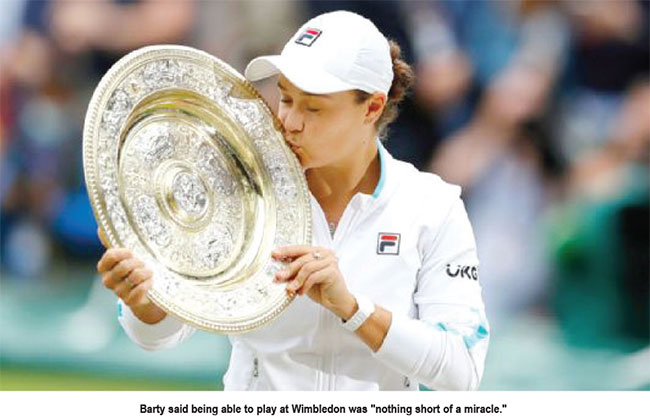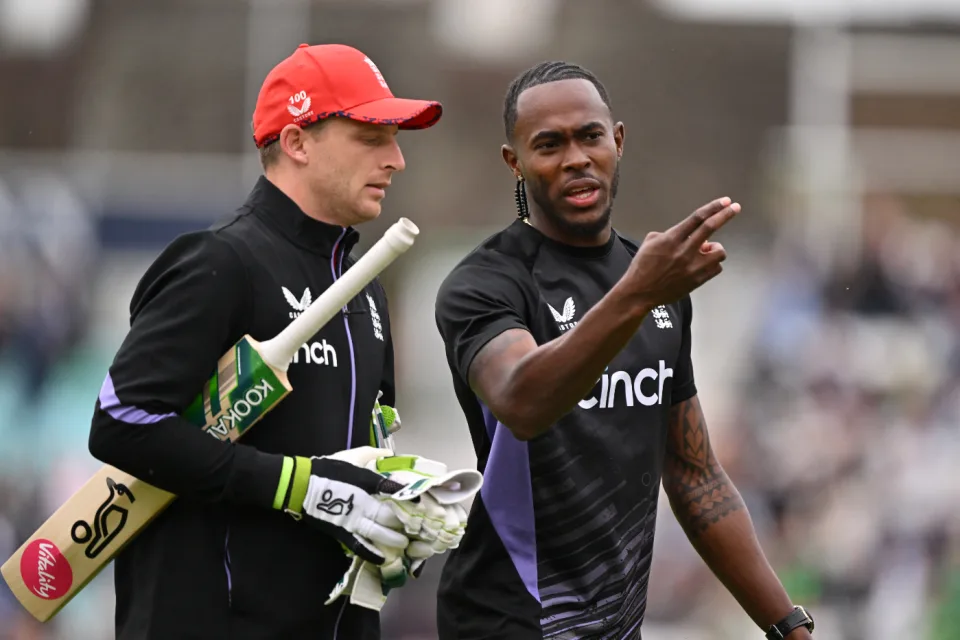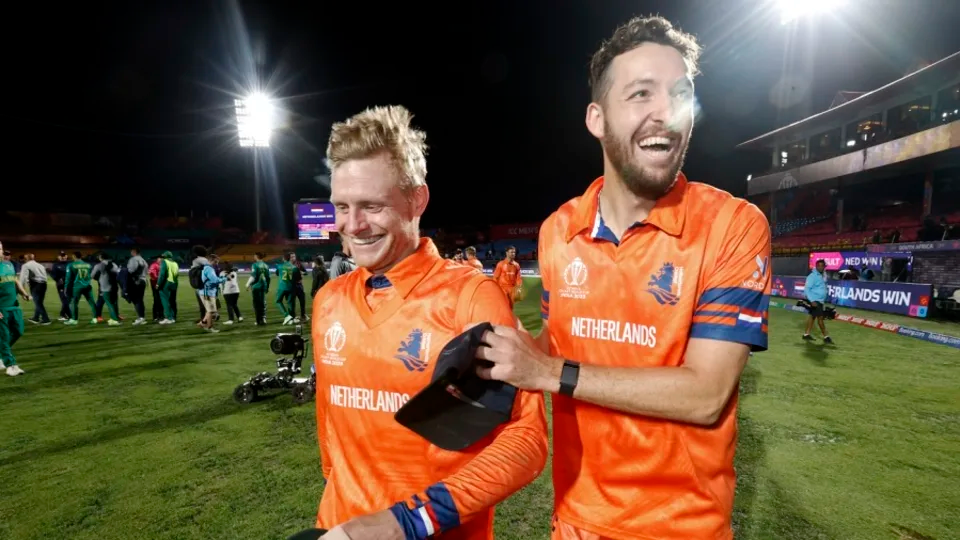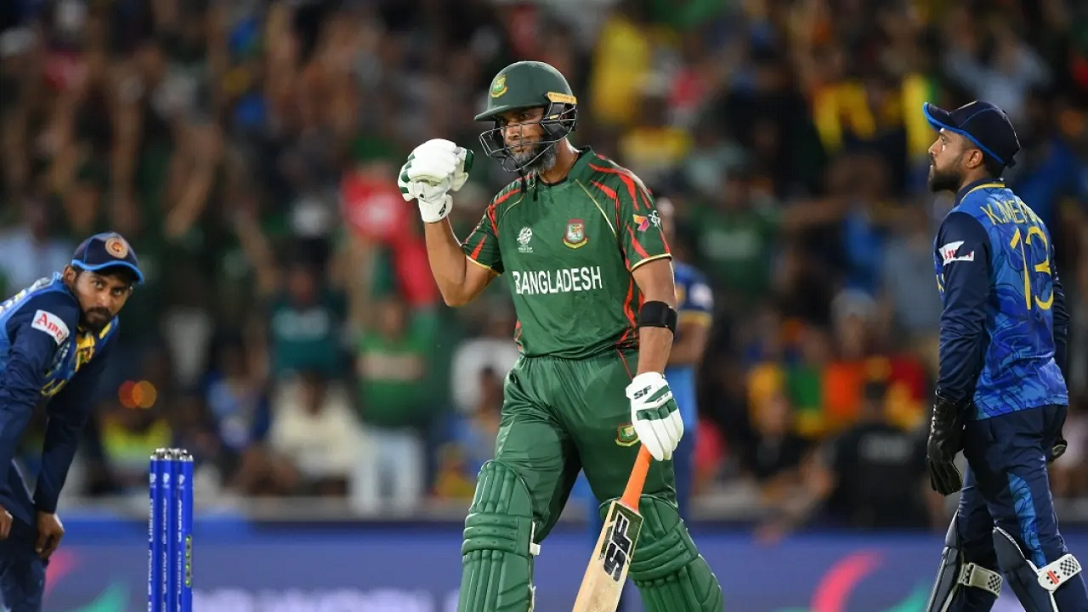Sports
Ash Barty felt right at home as she won the Wimbledon title

Ash Barty made her intentions known before Wimbledon began.
“One day, I would love to be the champion here,” Barty said late last month, three days before her first-round match. “It’s a dream. It’s a goal.”
A lifelong student of the game, Barty has been enamored by the tradition and history of the event since childhood — since she first picked up a racket, winning the title is what she has most wanted.
In the final at the All England Club against Karolina Pliskova, it all came together.
The 25-year-old Barty put forth a staggering effort from the moment she took the court. She won the first 14 points of the match, and 16 of the first 18 to jump out to a 4-0 lead. It took more than eight minutes for Pliskova to win a point. Pliskova eventually found her level and Barty had to fight even harder, but in the end, she won her second major title following a 6-3, 6-7 (4), 6-3 victory in just under two hours.
The achievement was made even more special, coming on the 50th anniversary of fellow Indigenous Australian Evonne Goolagong Cawley’s first Wimbledon title. Throughout the fortnight, Barty had worn a scallop-hemmed skirt in homage to Goolagong Cawley, whom she considers a mentor, and she wanted to carry on her legacy.
“It took me a long time to verbalize the fact that I wanted to dare to dream it and say I wanted to win this incredible tournament,” Barty said on court after the match. “Being able to live out my dream right now with everyone here has made it better than I could have ever imagined. I didn’t sleep a lot last night, I was thinking of the what-ifs, but when I was coming out on this court I felt at home in a way.”
Saturday’s result, of course, would have hardly been a surprise to anyone who watched her win the Wimbledon girls’ title 10 years ago. But Barty’s career has been anything but a straight line since.
After a stellar junior career, the expectations were high once she turned professional but life on tour wasn’t what she expected. Though she reached three major doubles finals before her 18th birthday, she missed her family and her homeland during the week-to-week globetrotting grind.
Burned out and looking for a change, the 18-year-old headed home after the 2014 US Open, and traded her racket for a cricket bat. She took an 18-month break from tennis and played in a professional cricket league in Australia.
Eventually, her love for tennis came back. She started working with Craig Tyzzer, who remains her coach, then made her return in 2016, playing exclusively in ITF events in Australia before turning her sights to the grass and her favorite Grand Slam. She made the quarterfinals (where she faced Pliskova) in her first WTA event in nearly two years at Nottingham, then lost in the second round of qualifying for Wimbledon. She played in just one more tournament that year, but the spark had returned.
She won her first WTA title at the Malaysian Open in March 2017, and played in two more finals that year. Her ranking soared and she cracked the top 20 by year’s end. But her confidence still needed time.
“It’s something that she’s worked on over the years and we’ve identified,” Tyzzer said on Friday. “There have been times when she just questioned herself. … She’s handling that stuff a lot better.
“It’s an ongoing thing. It’s like hitting a forehand and backhand, you just keep working on it, you keep building. She’s getting better and better at those things all the time.”
Tyzzer said Barty wouldn’t have been ready to publicly declare her dream to win Wimbledon in the early years of her return, even following her first major title at the French Open in 2019. But now she was willing to put it out there, knowing she might fail.
In her four previous main draw appearances, she had never made it past the fourth round, but the cancellation of the 2020 tournament due to the coronavirus pandemic reminded her just how much she loves the event.
Despite having to retire during her second-round match at the French Open last month due to a hip injury — something she called “heartbreaking” at the time and said Saturday is normally a two-month recovery process — and not being able to play in any of the lead-in events on grass, Barty was determined to compete at Wimbledon. Her team tried to shield her from the details of her injury to keep her focused.
“Being able to play here at Wimbledon was nothing short of a miracle,” Barty said. “I think them not telling me [the likelihood of being able to play] just proved how much we were against the odds. I think now, to be playing pain-free through this event was incredible. It’s funny, sometimes the stars align, you can think positively, you can plan, and sometimes the stars do align. You can chase after your dreams.”
Barty’s early match dominance was threatened in the second set of Saturday’s final. Pliskova broke Barty in the 12th game of the fiercely contested set to force a tiebreaker and then a decider, the first in the women’s final at Wimbledon since 2012. But Barty left nothing to chance at that point, taking the first three games and closing out the match on serve.
When it was over, she crouched and put her head in her hands as a star-studded crowd, including the Duke and Duchess of Cambridge, Billie Jean King, Martina Navratilova and Tom Cruise, showered her with a standing ovation.
Normally stoic, Barty couldn’t hide her emotions as she climbed to her player box to embrace her team. When she returned to the court for the on-court ceremony, she became the fourth Australian woman to hoist the trophy at Wimbledon, and the first since Goolagong Cawley won her second title in 1980.
“I hope I made Evonne proud,” Barty said on court before stepping away from the microphone as she began to choke up.
She later explained how much Goolagong Cawley has meant to her.
“Evonne is a very special person in my life,” Barty said. “I think she has been iconic in paving a way for young Indigenous youth to believe in their dreams and to chase their dreams. She’s done exactly that for me, as well. I think being able to share that with her and share some pretty special victories now with her, [and] to be able to create my own path is really incredible, really exciting.”
Barty has owned the top spot in the rankings since September 2019. Some questioned the legitimacy of the revised ranking system and her No. 1 status as she opted to skip the remainder of the 2020 season once it resumed, but she has left no doubt now. She’s 2,299 points ahead of No. 2 Naomi Osaka going into the hard-court season and will be a favorite at the upcoming Olympic Games and the US Open.
Wimbledon marks her fourth title, and fifth final, this year. She is now just the third woman to have won multiple Grand Slams since the start of the 2017 season, joining Osaka and Simona Halep, and no one has won more WTA titles during that stretch than Barty with 12.
Barty didn’t talk about her ranking or her place among the sport’s latest superstars on Saturday. She seemed more than content with taking in the moment that had been a long time coming.
“Dreams don’t always come true, but you can fight and do everything you can to give yourself that opportunity,” Barty said ahead of the tournament. “That’s been a lot of my learnings over the last two years as a person, not just as a professional tennis player, but as a person, is putting my hopes and dreams out into the universe and chasing them.” (ESPN)
Sports
England face Australia in the battle of champions

The first truly heavyweight clash of this expanded T20 World Cup format comes freighted with both history and subplots. A rematch of the 2010 World T20 final at Kensington Oval, the match pits Jos Buttler’s defending champions – who are aiming to become the first team to retain the trophy – against the Australian winning machine, victors at the 2021 edition and current world title-holders in Test and ODI cricket. And that’s before you throw in the Ashes for afters.
Already there is added pressure on England, after the rain in Bridgetown led to a share of the points in their opener against Scotland (and that having conceded 90 runs from 10 overs without taking a wicket in a tepid bowling display). Lose to their oldest rivals and it will leave their Super 8 prospects open to being waylaid by the perils of net run-rate calculations, or worse.
The Scotland match was the third abandonment in five suffered by England, after a rain-affected home series against Pakistan, which has clearly hampered their readiness for this campaign after almost six months without playing T20 together. It does not take much for a side to click in this format – and England looked in decent shape when they did get on the field against Pakistan – but Buttler will be anxious for things to go their way on Saturday, if only to avoid further questions referencing the team’s disastrous ODI World Cup defence last year.
Australia, under the laidback leadership of Mitchell Marsh would love nothing more than to add to the English sense of jeopardy – having helped bundle them out of the tournament in India on the way to taking the crown. Their head to head record is less impressive in T20 however, with England having won six of the last seven completed encounters, as well as that 2010 final.
Despite a wobble with the bat, Australia avoided mishap against Oman earlier in the week, the experience of David Warner and Marcus Stoinis shining through in difficult batting conditions. Surfaces in the Caribbean – not to mention those games staged in the USA – have already had teams scratching their heads; rather than the “slug-fest” England had prepared for, following a high-scoring tour of the Caribbean in December, it looks as if boxing smart may be the way to go.
Speaking of Warner, this could be the last time he faces up against England in national colours – and another match-winning contribution would likely reduce the chances of them meeting again in the knockouts. On the other side of the card is Jofra Archer, fresh from an emotional maiden outing at Kensington Oval and ready to take on Australia for the first time in any format since 2020. Can Mark Wood fire up England’s campaign, as he did during last summer’s Ashes? Will Pat Cummins be back to harass the old enemy once again? Seconds out, it’s almost time to rumble.
Cummins is set to return after being rested for the Oman game, which saw Mitchell Starc leave the field with cramp. Starc is understood to be fine and could keep his place – which would likely see Nathan Ellis miss out. Marsh is still not fit to bowl, with Australia likely to continue with the allrounder combination of Stoinis and Maxwell to give them cover.
Australia (probable XI): David Warner, Travis Head, Mitchell Marsh (capt), Glenn Maxwell, Marcus Stoinis, Josh Inglis (wk), Tim David, Pat Cummins, Nathan Ellis/Mitchell Starc, Adam Zampa, Josh Hazlewood
The one change England may consider is Reece Topley coming in for Wood, with the expectation that there will be some rotation among the seamers through the course of the tournament.
England (probable XI): Phil Salt, Jos Buttler (capt & wk), Will Jacks, Jonny Bairstow, Harry Brook, Liam Livingstone, Moeen Ali, Chris Jordan, Jofra Archer, Adil Rashid, Reece Topley/Mark Wood
[Cricinfo]
Sports
South Africa up against their bogey team in batter-unfriendly New York

Once is coincidence, twice is a clue, and three times is proof.
To paraphrase Agatha Christie, that is the narrative around South Africa’s meeting with Netherlands at this T20 World Cup.
The Dutch beat South Africa at the 2022 tournament and ended their semi-final hopes in a match where South Africa appeared to be sleep walking, and then beat them again at the 2023 ODI World Cup, where they exposed South Africa’s vulnerability in the chase. If they to do the treble, not only will Netherlands take the lead in Group D, but they will offer conclusive evidence of the threat they pose to Full Members, especially South Africa.
Of course, it will take some doing after South Africa’s opening performance against Sri Lanka, where they reduced their opposition to their lowest T20I total and chased it down in fairly straightforward fashion thanks to the most stable middle-order of their white-ball era. In Aiden Markram, Tristan Stubbs, Heinrich Klaasen and David Miller, South Africa have bankers and big-hitters and, for this match, they also have the advantage of experience. They’ve already played at Eisenhower Park, and have first-hand knowledge that run-scoring doesn’t come easily;Klassen said they are prepared to use their “cricket brains” and play “smarter cricket”.
But the conditions could be good news for Netherlands, who are not naturally a line-up of big hitters and build their innings on a foundation of turning ones into twos. In other words, they tend to take a slightly more conservative approach to batting, which may work well here, but they’ll be wary of the uneven bounce of the surface and will have to come up with plans to counterattack especially against South Africa’s seamers. Their own bowlers were exemplary in Dallas and will look to build on that performance against a line-up that will likely be more proactive than Nepal’s, but who they have managed to keep quiet not once, but twice in the past. Third time’s the charm, they say.
Anrich Nortje’s stunning return to form against Sri Lanka means South Africa may not have to tinker with the bowling combination, and Gerald Coetzee and Tabraiz Shamsi may have to wait their turns to get a game. The batting line-up should be unchanged, with no space for Ryan Rickelton yet.
South Africa: Quinton de Kock (wk), Reeza Hendricks, Aiden Markam, Tristan Stubbs, Heinrich Klaasen (wk), David Miller, Marco Jansen, Keshav Maharaj, Kagiso Rabada, Ottneil Baartman, Anrich Nortje
Conditions in New York may tempt Netherlands to include an extra seamer and they have Kyle Klein in their squad. But it could come at the expense of a shortened batting line-up and they may not want to risk that.
Netherlands: Michael Levitt, Max O’Dowd, Vikramjit Singh, Sybrand Engelbrecht, Scott Edwards (capt, wk), Bas de Leede, Teja Nidamanuru, Logan van Beek, Tim Pringle, Paul van Meekeren, Vivian Kingma
[Cricinfo]
Latest News
Mustafizur, Rishad, Hridoy dazzle in Bangladesh’s tight two-wicket win over Sri Lanka

Nuwan Thushara’s last over brought Sri Lanka screaming back into the match,as he first bowled Rishad Hossain, and then nailed Taskin Ahmed in front of the stumps with a pinpoint swinging yorker. This left Bangladesh eight wickets down, with 12 runs still to get.
However, the experienced Mahmudullah was at the crease for Bangladesh, and despite some further nervy moments, pushed Bangladesh across the line off the last ball of the 19th over.
But this was a match chiefly decided by Bangladesh’s own outstanding bowling. Mustafizur Rahman was the best among them, using shorter lengths and his cutters efficiently, to claim figures of 3 for 17. Rishad Hossain’s three-for through the middle overs also kept Sri Lanka quiet.
Mustafizur was instrumental in Sri Lanka’s downward spiral through the middle overs, which culminated in a crash-and-burn end. Ultimately, their inability to find boundaries, or even rotate strike against good Bangladesh bowling resulted in their downfall. A score of 125 for 9 always seemed poor on a decent pitch, even if their bowlers made a match of it in the end.
Brief scores:
Bangladesh 125 for 8 in 19 overs (Towhid Hridoy 40, Litton Das 36; Dhanajaya de Silva 1-11, Nuwan Thushara 4-18, Wanidu Hasaranga 2-32, Matheesha Pathirana 1-27) beat Sri Lanka124 for 9 in 20 overs (Pathum Nissanka 47, Dhananjaya de Silva 21; Tanzim Hasan Sakib 1-24, Taskin Ahmed 2-25, Mustafizur Rahman 3-17, Rishad Hossain 3-22) by two wickets
[Cricinfo]





















